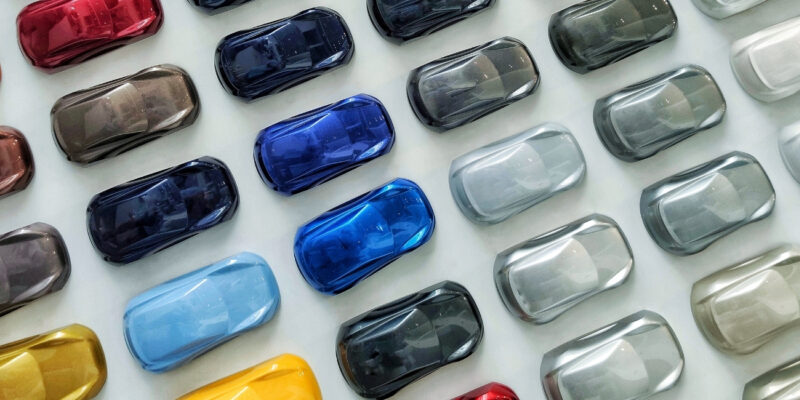
When it comes to buying a new car, the colour might play more of a role in your decision than you think. New car buyers can spend hours agonising over colour codes, while used car buyers will likely find themselves eliminating certain options based on the paint job alone.
Indeed, colour is quite an interesting and unique feature of a car. It doesn’t affect performance or functionality in any way, but it does impact buying decisions from a number of angles. Here, we’ll take a look at just how much colour can affect the key financial aspects of a vehicle, and what you can do if you’re thinking of adding a fresh lick of paint to your current vehicle.
How much does car colour matter – and what does it affect?
It shouldn’t come as too much of a surprise that the colour of your car does matter. It is, after all, a rather fundamental aesthetic element that’s virtually impossible to ignore. And, as we well know, most of us value a car that looks the part alongside being a solid performer.
Even with that said, you might not be aware of just how important a factor colour can be. It can affect a vehicle on many fronts, including:
- Resale value: Neutral colours make selling or trading-in much easier thanks to their widespread popularity. Unsurprisingly, a black Mercedes S-Class will typically sell much quicker and for more than the same car draped in pistachio green.
- Theft prevention: Car thieves tend not to steal at random, but rather go after cars they know to carry the best resale value and will sell quickly. As such, your vehicle is more susceptible to criminal activity if it’s in a common, popular colour.
- Maintenance: If you’re concerned about keeping your car in the best possible condition, it’s worth knowing that darker hues are typically more difficult to maintain. That’s because lighter shades tend to hide scratches better and wear and tear is generally more apparent on darker tints.
- Safety: Numerous sources of research suggest some car colours are more dangerous than others, in terms of increasing your chances of being in an accident. However, this is a more ambiguous debate than others, with different sources pointing to different colours as more hazardous. More on that below.
Of course, beyond the practical areas mentioned above, there’s also the overriding aesthetic element and ‘cool factor’ to consider, but that’s more of a subjective matter that depends on your tastes as an owner.
What colour car holds its value best?
In a car market where depreciation hits new vehicle values hard, it makes sense to choose a car with strong value retention qualities. In many cases, beyond the popularity level of the model itself, colour can play one of the more significant roles in determining resale value and buyer decisions. But what are the safest colours to go for if you’re looking to protect your investment?
The long-standing ‘big five’ top colours for retaining resale value are black, grey, silver, blue and white. However, a three-year sales analysis (2017-2020) from iSeeCars found four unexpected options – yellow, beige, orange and green – were all more resistant to depreciation than the big five. Three-year deprecation averages for the four more unusual colours ranged from 20.4-31.3%, while the ‘big five’ covered a range of 36.4-38.4%.
It's worth bearing in mind the much-reduced quantity of sales and different new and used price values of the less common colours. However, it’ll still come as a surprise to many that you can potentially step outside of the accepted colour norm and come out on top when it comes to a car’s resale value.
Which colour cars have the most accidents?
What colour car is most likely to crash? The answer to this important safety question depends on who you ask.
Research from Citywide Law Group and Kelley Blue Brook suggests the most dangerous colour car to drive is black. One study found that you’re as much 47% more likely to be in a crash, although more conservative estimates sit at the 10-20% mark. Making up the top five behind black cars were grey (11%), silver (10%), blue and red (both 7%).
The logic behind these studies is that black cars are least visible in the dark, thus increasing your chance of being in an accident at night. However, the same argument could be aimed at white or grey cars when driving on typically dreary British days or in snow or fog.
It’s an environmentally influenced debate that really shouldn’t have too much of an impact on your decision-making, but an interesting one all the same.
Does changing the colour of your car affect insurance premiums?
One area where buyers needn’t worry about loss of value is with their insurance premium. While oddly coloured vehicles might struggle to sell on the open market, your insurer cares little whether your car is the brightest of pinks or the blandest of brown. Indeed, the claim that ‘risky’ colours like red and yellow increase premiums is a myth.
However, things are a little different if you choose to change your car’s colour. Any colour or design change, such as colour wrapping, custom paintwork or adding stickers and decals, is considered a modification by most insurers. Any modification that moves your vehicle away from the industry standard or adjusts your car’s sale value will likely increase your yearly premium cost.
What is the most popular car colour?
As per the Society of Motor Manufacturers and Traders, grey retained its place at the top of the colour popularity charts for 2020, with 397,197 units registered. As for the year’s top 10, the rest of the aforementioned ‘big five’ colours and red combined to make up over 95% of the total sales.
The UK’s car market share by colour in 2020
- Grey: 24.4%
- Black: 19.9%
- White: 17.4%
- Blue: 16.9%
- Red: 9.0%
- Silver: 7.5%
- Orange: 1.3%
- Green: 0.9%
- Yellow: 0.4%
- Bronze: 0.1%
Can I change the colour of my car?
As we’ve established, you’re free to make colour modifications to your car as long as you’re happy with the implications they carry for your car’s resale value and insurance cost.
Here’s a quickfire guide on how to change the colour of your car properly.
How to find the colour code of your car
If you’re looking to find out your car’s colour code for a touch-up, you’ll typically be able to find it either inside the glove box or the wheel well. If you have no luck there, check the driver’s side door jamb, under the driver’s seat, under the bonnet or in the passenger seat sun visor.
Once you have your colour code information, you’ll be able to create an exact paint match for it.
How much is it to change the colour of your car?
Assuming you’re heading to a professional for a colour change (we’d not recommend having a go yourself), you can expect to pay a hefty bill. Exactly how much you pay will depend on your model and the extent of the job, but you can expect to spend anywhere from hundreds to thousands of pounds to get the work done.
How to register a change of car colour
Once you’ve completed the colour change, one thing you must do is update your vehicle’s V5C registration certificate and inform the DVLA. A colour change will not affect your car tax, but it’s essential you officially log the modification.
Find your colour with Jardine Motors
While we’re not here to tell you what your car colour says about you, we are here to provide you with an incredible range of new and approved used luxury cars, available in a wide variety of colours ranging from safe and neutral to standout and showstopping.
If you’d like to take a look at what we’ve got to offer, why not head down to your local Jardine dealership, or get in touch with a member of the team. We’re also available via virtual appointment, which you can book online.
You might also like
Upgrading a base model car – is it worth it?
Car cleaning tips: 8 steps to clean your car like a pro
Don’t forget to visit our YouTube channel, where you can find all sorts of car reviews and expert advice.



